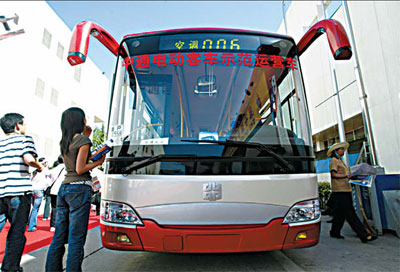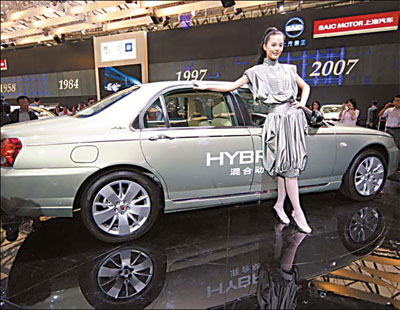Clean energy is the focus of the auto industry this year. It better be because the government is now determined to save energy and control the emission of greenhouse gases (GHGs).
The clean energy wind began blowing across China's auto industry when Toyota introduced its hybrid car, Prius, in January 2006. Almost all global auto giants are bringing their energy-efficient technologies and vehicles to China, and domestic carmakers, too, have realized the importance of clean energy research and development (R&D).
A hybrid bus is displayed at the 2007 Beijing International Sci-tech Exhibition.
Clean energy has become a pre-requisite and must-do for all automakers. "It's a sound response to the energy crisis, the call for an environmentally-friendly world and the government's encouraging policies," says auto consulting firm Sinotrust's analyst Sun Qi.
The National Development and Reform Commission (NDRC) issued the Guiding Catalogue of Industrial Structure Regulation in 2005, encouraging new energy automobile R&D. In December last year, the NDRC issued a draft catalogue, reconfirming the importance and immediacy of clean energy in the auto industry. A month before releasing the draft, the NDRC had also drawn up management regulations for introduction of new energy in auto production.
Beijing will implement China IV emission standards from next month. The Beijing Olympic Games and Shanghai 2010 World Expo will further boost China's green drive, with promises of encouraging low or even zero emission vehicles. All this has made hybrid cars a lucrative prospect.
Another reason automakers are looking at hybrid cars is oil. Crude oil prices crossed the psychological barrier of $100 a barrel and were hovering around $98 yesterday. Just in 2003, the price was $25 a barrel.
Sun, however, says China's auto industry has yet to find the right direction and develop an efficient way to cut GHG emissions because R&D into clean energy has been diversified into many channels, from hybrid, electric vehicles to substitute energy of hydrogen, ethanol, ether and bio-fuel.
Most analysts generally consider hydrogen-powered vehicles to be the best way to achieve zero emission and high-energy efficiency. But they concede that the exorbitant R&D cost, difficulty in building facilities and getting enough and uninterrupted supply of hydrogen make manufacturing such vehicles almost impossible in the near future.
That's why 2008 can be the year of hybrid vehicles, a transitional and feasible solution in the clean energy journey, Sun says. Hybrid vehicles can cut energy consumption by 10 to 50 percent. Therefore, "gasoline-electric hybrid vehicles may only resolve the energy crisis for the moment".
Hybrid cars have gained so much favor among makers and buyers that European and US auto conglomerates, which till now had been concentrating on hydrogen-powered vehicles, have began shifting their focus. And analysts say hybrid cars offer domestic firms a chance to share the global stage with their international rivals.
Prius is the only one, with a small production unit in China, to receive a good response. Other imported hybrid models have not been that successful because of their high prices. As a result, in the past two years many auto joint ventures and domestic brands have set up projects in the hope of developing new models.
Chang'an Auto Corp, China's fourth largest automaker, is the first to go into mass production of hybrid cars. The country's first hybrid sedan Jiexun-HEV rolled off the production line at a Chang'an plant in Chongqing in December. To cost between 130,000 and 150,000 yuan ($18,200 and $21,000), it is expected to hit the market soon. Six years of intensive R&D preceded the mass production of Jiexun-HEV.
A Ministry of Science and Technology official says the new sedan has been developed using Chinese patents for the engine and hybrid power system, or the entire car. This is the beginning of mastering the core technologies of the hybrid-power system by a Chinese firm.
Chang'an Auto president Xu Liuping says Jiexun-HEV is a breakthrough in the "electricity run automobile program", which is part of the "863 plan", China's strategic high-tech research development plan created in 1987. The car has a fuel-battery hybrid technology and consumes 20 percent less fuel compared to traditional cars. Its emission meets standard IV, the highest yardstick in China.
Chery Automobile Co in Anhui province is also out to cash in on the hybrid car craze. The carmaker's spokesman Jin Yibo says a hybrid car model, based on A5, is already being tested as a taxi on the roads of Wuhu, where Chery's plant is located. The company may officially launch the car later this year.
Another Chery hybrid car could hit the market in the second half of the year, says Jin. Chery assigned British Ricardo Co, a leading provider of technology, product innovation and engineering solu tions, to develop a hybrid vehicle in 2004.
And then there's BYD Auto, a cell-phone battery company that entered the auto business in 2005 and plans to unveil a hybrid car model, F6DM, in the later half of the year. The car is expected to cost 150,000 yuan ($21,000).
Other domestic firms trying to enter the clean energy vehicle market include Zhejiang Geely Holding Group Co and Great Wall Motor. But they are not concentrating on hybrid technologies only. As Jin says, hybrid vehicles are just the first step in its clean energy strategy, "for hybrid is well known to the public and easily accepted by the market".
Jin, however, concedes that hydrogen fuel cell vehicles are the best answer to the problem now, even though it's difficult for automakers to produce them on a mass scale because of the high cost and technological constraints. Chery, however, is developing electric and other car models.
Great Wall has already begun four projects, including the use of methanol to run cars. All the projects are likely to be completed by next year.
But all the automakers hope the government would come up with policies to boost the demand for new energy vehicles, instead of just encouraging R&D. "After automakers commercialize the new energy vehicles, the government should encourage consumers to buy them by offering favorable taxation. That could help China's new energy auto dream become a reality," says analyst Zhong Shi.
Roewe 750 Hybrid car is featured at the Shanghai International Autoshow in April last year. The car, made by the Shanghai Automotive Industry Corporation, can save as much as 25 percent of gas.
(China Daily February 22, 2008)









